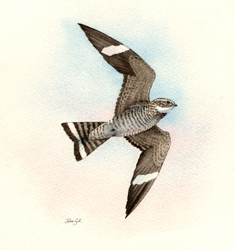Breeding Bird Atlases (BBA)
Find a Bird - BBA1
Breeding Bird Atlas 1 Species Accounts
Common Nighthawk
Chordeiles minor
Egg Dates
May 31 to July 25
Number of Broods
one; may re-lay if first attempt fails.

The Common Nighthawk is one of the most widespread breeding birds in North America, though it is now rather local in Massachusetts. This species is more or less confined to the larger cities in the state such as Boston, Cambridge, Worcester, Springfield, and Pittsfield and to other smaller communities where buildings with flat, graveled roofs are present. Before 1900, it was a common summer resident in the pine barrens of the coastal plain and locally inland in burned-over fields and pastures. The extensive reforestation of the vast agricultural areas of the 1800s has undoubtedly contributed to the population decline. There are recent confirmed breeding records for some areas in the Myles Standish State Forest in Plymouth, but increasing human population elsewhere in Plymouth County has substantially decreased the amount of suitable habitat for ground-nesting nighthawks.
The first nighthawks generally arrive by mid-May, but the bulk of the migration occurs during the last week of May and early June. There are a few records for late April and early May, but these are usually storm-driven stragglers. The number of migrants reported in the spring is but a fraction of those of the mass movements that occur in the fall.
To the aware city stroller, the call of the nighthawk is one of the more familiar sounds of summer. It is most often described as an abrupt peent, strongly accented at the beginning. This call is uttered only while the nighthawk is in flight and functions as a territorial call. The migrating individuals in flocks seldom call in the fall. Nighthawks also make a resounding boom during courtship. The male rises to a considerable height, then dives with wings folded, and ends by swooping sharply upward. During the dive, the stiff outer primaries vibrate, producing the resonant booming sound.
The nighthawk builds no nest but lays two eggs on the ground in sparsely vegetated or burned-over areas or on graveled roofs of flat-topped buildings in cities. Rooftop nesting may be more successful than ground nesting because of fewer predators and a decreased possibility of flooding. Another reason for increased success is that the lights of the city attract a continuous supply of insects for food. The cryptically colored eggs are cream to pale gray and dotted with gray and brown. Incubation, done by the female alone, lasts 19 days on average. The male may feed the incubating female and also helps care for the young. If a potential predator comes in contact with a nesting nighthawk, the parent engages in the classic routine of feigning a broken wing and hissing at the intruder. Nighthawks are known to move both eggs and young in an effort to escape extreme heat or flooding. Young birds usually fly by 21 days after hatching and remain dependent for a short time thereafter.
The following is a summary of the data for five Massachusetts nesting attempts. One set of two eggs was discovered on May 31 (DKW). A pair nesting on a roof in Athol performed the distraction display on June 22. At that time the young were quite well feathered but still showed some down (Klunk). Three ground nests were located in the Myles Standish State Forest. At one, a female and fledgling were present from July 12 to July 28. The second record was of eggs on June 29, but these apparently never hatched and were still present on August 19. Two young about 2 days old were found at the third nest on June 25, but both subsequently disappeared, presumably lost to a predator. However, this pair renested. On July 5, there was one new egg, and there were two eggs on July 11. On July 28 a 2- or 3-day-old chick was observed (BOEM).
On warm calm nights in late August and early September, a pronounced fall migration occurs. Most migrants are associated with well-defined river valleys such as the Connecticut River valley, where counts exceeding a thousand individuals are occasionally observed under ideal conditions. Common Nighthawks also often gather in numbers to feed on flying ant swarms. Most of the fall migration is over by September 10, with only a few birds lingering past that date, most noticeably on the Cape and Islands. Common Nighthawks winter in South America south to Argentina.
Map Legend and Data Summary
Atlas 1 data collected from 1975-1979


Note: uncommon and local on rooftops of larger cities; ground nesting recorded in Plymouth County
Robert H. Stymeist



